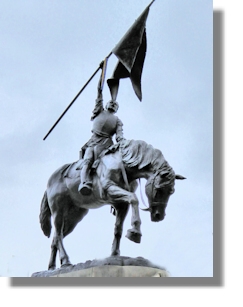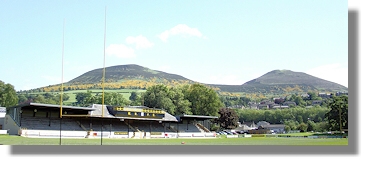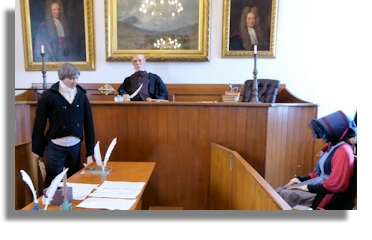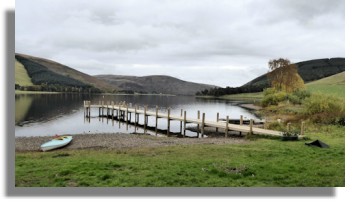 A Tour of the Scottish Borders - Borders Towns
A Tour of the Scottish Borders - Borders Towns
 A Tour of the Scottish Borders - Borders Towns
A Tour of the Scottish Borders - Borders Towns

Melrose
Just as the Border region is distinct in its landscape, history and character, so too is each of the charming towns which are scattered across the Tweed valley. Melrose offers the ideal base in order to tour around the vicinity to visit Abbotsford, enjoy some healthy hill walking or delve into the Roman archeology of the past. The triple peaks of the Eildon Hills are an impressive landmark, the foothills stretching down to the Tweed. The hills, one named the Magic Mountain, were a sacred place by the Celtic priests who performed fire festivals to ward off evil spirits and human sacrifice to the vengeful sky gods. The Eildons are believed to have been created by an alchemist wizard Michael Scott and it was here that Thomas the Rhymer was given the gift of prophecy by the Faerie Queen. Magic and mysterious legends aside, the hills are perfect for an energetic walk, easily reached from the town centre.
Melrose is also the starting point for the St. Cuthbert's Way, a 62 mile trek to Lindisfarne, the Holy Isle. The fully signposted route opened in 1996, the following year winning a national tourism award for such an attractive and innovative venture that encourages people to walk in the countryside as well as recognises this ancient pilgrimage. Maps, guides and accommodation leaflets are available to assist you on this journey.
And of course there are the majestic ruins of Melrose Abbey, with Robert the Bruce's heart buried in the grounds. And nearby is Harmony House and Garden, a National Trust for Scotland property with handsome Georgian villa looking out onto a beautifully tended garden of smart croquet lawns, colourful, scented flowerbeds, fruits and vegetables. Harmony Garden plays host to the Borders Book Festival each June.

Rugby is a major sport in the borders especially in Melrose where the first Rugby Sevens tournament was played at the Greenyards ground in Melrose in 1883. The game is now played on an global stage and is testimony to its founder in the Scottish Borders town. The backdrop to the ground is formed here by the Eildon Hills.
And if you are keen on finding out more about the Roman settlements in the Borders, there is the Trimontium heritage centre in Melrose with an exhibition of fascinating tools, coins and pottery. A guided walk to the Trimontium fort at Newstead and other Roman sites takes place on selected days.

Selkirk
The Royal Burgh of Serkirk six miles south of Melrose is also worth a visit to see other historical sites including the Courthouse where Walter Scott served as Sheriff for 30 years. There's also a statue to Mungo Park the famous 18th century explorer who was born near here. Visit the town in June to witness one of the most traditional pageantry events. The Selkirk Gathering, or Common Riding is the largest of the Border Ridings, and this festival dates back to the Battle of Flodden in 1513.
From Selkirk enjoy a relaxing drive along the meandering A707 beside the Yarrow Water to St. Mary's Loch, a beautiful, restful spot in this rather remote and unspoilt part of the Borders. There is a spectacular waterfall, the Grey Mare's tail (just outside the Scottish Borders into Dumfries & Galloway) which plunges 200 feet from an overhanging cliff-face and if you don't mind a precipitous drop beneath, you can climb up to the foot of the falls.
This area around St Mary's Loch is closely linked with the life and work of James Hogg, The Ettrick Shepherd, another notable Borders writer and a good friend of Scott. His famous work is The Confessions of the Justified Sinner and he spent his entire life around the Ettrick and Yarrow valleys.
"Having been born amongst mountains I am always unhappy when in a flat country. Whenever the skirts of a horizon come on a level with myself, I feel myself quite uneasy".
James Hogg, a letter to Sir Walter Scott, 1801.

The Yarrow valley and St. Mary's loch is a perfect place to explore by car or foot and there are several hotels, restaurants and bars for a welcome refreshment. Most notable due to its cultural connections is Tibbie Shiels Inn right at the far end of the loch where Hogg and Scott would sit and chat for hours over a dram or two. This is well worth a stop for a drink or meal - even stay over. The walls are covered with a fascinating display of photographs and pictures depicting the area over the years. Nearby is a memorial statue to James Hogg, the Ettrick Shepherd. If you enjoy walking, from the Inn you can also pick up the Southern Upland way to Ettrick and Moffat. And there is a sign-posted walk all the way round St Mary's Loch.In the Ettrick Valley near Selkirk is the 16th century Aikwood Tower, now beautifully renovated and preserved by Lord and Lady Steel. The museum here is dedicated to James Hogg with an exhibition that gives an insight into his life and work.
Hawick
Hawick is one of the farthest towns from the sea in Scotland, in the heart of Teviotdale, and the biggest town in the former county of Roxburghshire. Hawick's architecture is distinctive in that it has many sandstone buildings with slate roofs. The graphic on the left is Hawick Town Hall which is in the Scots "baronial style" which is common across the country for such official buildings - Renfrew and Dunfermline, for example have their city halls in a similar style. The town is at the confluence of the Slitrig Water with the River Teviot.Woollen mills used to be a major feature of Hawick and other Border towns too, utilising the large amount of wool produced by the sheep reared on the Border hills, but the industry has declined greatly in recent years.
Hawick is known for its yearly Common Riding and also for statues to the Battle of Hornshole fought in 1514 (the year after a major defeat of the Scottish army at Flodden) between youths from Hawick and an English raiding party. ("The Horse" shown at the top of this page, was erected in 1914 to commemorate the victory and the sculpture pictured on the right is a more recent one beside a museum (Heart of Hawick) created inside Drumlanrig's Tower, which dates largely from the mid-16th century. The two statues celebrate the capture of the English Flag by the youth of Hawick at a place called Hornshole.Long after they ceased to be essential, the ridings continued in commemoration of local legend, history and tradition. The Hawick Common-Riding is the first of these Borders festivals.
Many Hawick residents speak the local dialect of Border Scots which is informally known as "Teri Talk". It is similar (but not identical by any means) to the dialects spoken in surrounding towns, especially Jedburgh, Langholm and Selkirk.
Jedburgh
Just ten miles north of the Scottish border this is a very charming little town to wander around. The red sandstone Jedburgh Abbey on the banks of Jed Water was founded in 1138 by David I but during the Border battles it was ransacked and rebuilt many times. Jedburgh was strategically an important town and received the full brunt of the invading English armies.Mary Queen of Scots stayed in Jedburgh in 1566 when recovering from an illness after a journey to meet her lover, The Earl of Bothwell. You can visit her former house (pictured here on the left) which has a well presented exhibition about her tragic life.
There's also the impressive Jedburgh Castle Jail Museum at the top of the Castlegate hill. You can sample the local mint sweet, the Jethart Snails which were said to be made in the town by the Napoleonic prisoners of war being held in the Castle Jail. The cell blocks today depict what life was like behind bars in the 19th century.
Kelso
Kelso is notable for its imposing abbey. An abbey was originally founded by King Alexander I at Selkirk in 1113 but the Tironesian monks moved to Kelso when that abbey was established by King David I in 1128. The monks then started building the largest 13th century abbey in the Scottish Borders. The floor plan of the abbey in those days was in the shape of the cross of Lorraine - with two transepts or arms to the main building. The design was similar to that of abbeys on the river Rhine at that time, with solid looking turrets instead of a spire.
The abbey had considerable power and influence and its abbots at one stage claimed precedence over St Andrews Abbey. Later, King James III was crowned in Kelso Abbey in August 10, 1460, after the death of his father King James II at the siege of Roxburgh.
However, the story of the abbey thereafter is one of constant destruction by English invaders, many of whom passed through the area as the marched north into Scotland. In 1545 when the Earl of Hertford attacked the abbey, the defenders retreated into one of its towers but all 100 defenders and 12 monks were eventually massacred. By 1587 there were no monks left to look after the building. The ruins were used by the Covenanters (as a barracks) and part of the building was adapted as a local church.
Peebles
Beginning as a market town, Peebles played a role in the woollen industry of the Borders up until the 1960s. The town is now home to many people who commute to work in Edinburgh, as well as being a popular tourist destination, especially in the summer. In the mid-to-late 19th century health tourism, centring on hydropathic establishments, became important, the Peebles Hydro Hotel being one of the few survivors of that era. The graphic shows Old Parish Church and Bridge Inn (the bridge goes over the river Tweed) in Peebles.
Next page Country Mansions and the Great Outdoors > Page 1, 2, 3.
Or return to Index of Places to Visit
Where else would you like to go in Scotland?

